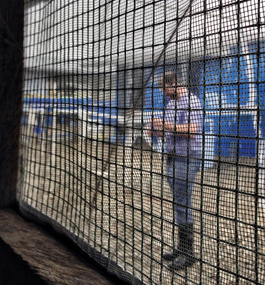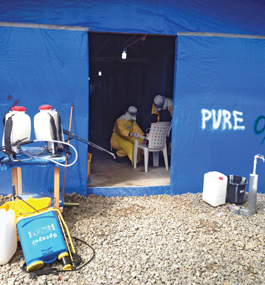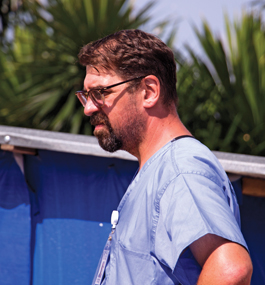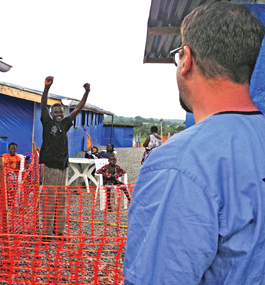Behind Enemy Lines
Fighting Ebola at a remote outpost in the Liberian jungle, infectious-disease specialist Steven Hatch ’91 contends with blood, sweat and fears.

Stuart Sia
RISKY BUSINESS: Hatch at the Bong County Ebola Treatment Unit, in Liberia.
by Leah Burrows
Oct. 21, 2014
Inside his dingy one-bedroom apartment in Suakoko, Liberia, Steven Hatch ’91 is already sweating when his alarm goes off at 6 a.m.
A cold shower would feel good, so he climbs out of bed and peeks into the shower stall to see if his roommate is there. The 6-inch dark-brown spider usually sticks to his corner of the bathroom, but a few mornings ago Hatch found him in the shower. The 6-foot-2-inch 45-year-old physician skipped showering that day.
The morning shower is mostly habit anyway. In the humid 100-degree jungle heat, Hatch will sweat through his clothes again before he finishes eating his breakfast.
Showered and fed, wearing a lightweight shirt and cargo pants, Hatch walks outside the faculty-housing building at now-shuttered Cuttington University, where he and a half-dozen other doctors are staying, and hops into a waiting SUV for the 15-minute ride to the brand-new Bong County Ebola Treatment Unit.
Maybe it’ll be cooler today, he thinks, eyeing the overcast sky. Maybe he won’t have to plan the shortest route when he walks between the center’s rudimentary wood-frame buildings, trying to avoid the burning sun.
An infectious-disease specialist at the University of Massachusetts Medical School, in Worcester, Mass., Hatch is one of a group of doctors volunteering for four weeks at this remote unit, run by the U.S. relief group International Medical Corps. It’s Hatch’s second stint in Liberia, his first since the Ebola outbreak began last spring.
No one has ever seen an Ebola epidemic like this one. By the end of October, more than 13,000 cases in West Africa had been reported, and deaths numbered almost 5,000, according to the U.S. Centers for Disease Control and Prevention. How long the virus will keep West Africa in its grip is a matter of educated speculation.
Among the dead is Abraham Borbor, whom Hatch befriended last year when he volunteered at John F. Kennedy Memorial Medical Center in Monrovia, Liberia, in the center’s first medical-residency program. Borbor, who was chief of internal medicine there, contracted Ebola after treating patients who carried the virus.
His death made Hatch’s decision to return to Liberia in October straightforward. “Dr. Borbor was, in many ways, like a brother to me,” he says. “He was committed to his profession. How could I not honor that commitment?”
Hatch has come to the epicenter of the epidemic, to challenge a formidable foe.
Out in the world
The return trip didn’t surprise Hatch’s wife, Miriam, or their 13-year-old twins, a boy and a girl, back home in West Newton, Mass. They’ve already seen him off on many trips to study deadly diseases — trips to jungles in Colombia, Venezuela, Brazil.
“I am an infectious-disease specialist,” Hatch says. “Firefighters fight fires. Police officers fight crime. Infectious-disease doctors fight infectious diseases. Why wouldn’t I go back to Liberia? Miriam understood why this was important to me from the moment I began to talk about it, and never really blinked.”
Hatch’s dedication to his field has social-justice roots, instilled during what he calls his “liberal Jewish pinko” upbringing and solidified at Brandeis. When he was considering pursuing a PhD in English after Brandeis, one of his English professors, Karen Klein, told him, “You won’t like graduate school. You are the type of person who needs to be in the world and part of the world.”
Klein was reminding him, Hatch says, “that ideas aren’t mere play toys of the intellect. They can transform the real world if applied correctly.”

Stuart Sia
EMERGENCY RESPONSE: The Entire Ebola unit, including the patient wards, was built from the ground up last summer.
page 2 of 4
Though he enrolled in the English graduate program at Case Western Reserve University, he left after receiving his master’s degree. He had always loved science and medicine but was turned off by the singular focus of pre-med undergraduates, their noses buried deep in MCAT prep, indifferent to the world around them. Now he realized a career in medicine would allow him to venture into the world and transform it in small ways.
Hatch got his MD at the University of Cincinnati College of Medicine and later an MSc in clinical investigation at the University of Massachusetts Medical School. He was intrigued by epidemics and the impact of HIV, malaria, tuberculosis and other diseases on the developing world.
His work took him all over the globe — to South America, where he studied dengue fever, and to sub-Saharan Africa, to train medical students in infectious-disease clinical practices.
Blue-tarp walls
The first five minutes of the drive to the Ebola unit are an easy cruise down paved road. Then, the SUV turns into the jungle, where sometimes everything goes to hell. A bumpy, treacherous road — its terminus is an active leper colony — has been scratched into the jungle floor. It’s often blocked by fallen trees or ill-equipped cars swallowed by the mud.
Today, though, the road is clear, and in 10 minutes Hatch reaches the unit, a collection of about a dozen buildings with tin roofs and blue-tarp walls, built from the ground up just last summer.
Two Ebola wards, long barracks separated from the rest of the buildings by a low fence, make up the heart of the complex. One ward is for patients suspected of Ebola infection; the other is for confirmed cases. Each holds about 35 beds, separated into two-person rooms. The other buildings are for staff — locker rooms, workrooms, a lunchroom.
A cemetery next to the complex has about 35 graves. In the unit’s first month of operation, mid-September to mid-October, about 150 patients were admitted. Roughly half were found to be infected with Ebola.
Gravel crunches underfoot as Hatch makes his way to the morning staff meeting. His shift mates, another doctor and about a dozen nurses and other staffers, gather around two whiteboards — one listing suspected cases and the other confirmed cases. Many patients were admitted last night; their names crowd the suspected board.
Hatch and his colleagues “run the boards,” discussing who needs what, divvying up responsibilities, separating confirmed from suspected cases. Remembering details is crucial, because once they enter the wards, there’s no coming back out to recheck something.
After the meeting, Hatch walks to the prep building. A mirror covers one blue wall, and boxes of gloves are stacked against another. It takes 20 minutes to get into the protective gear.
First, in a measure necessitated by the 90 percent humidity and the stifling layers he must wear, Hatch applies defogging solution to his goggles — his eyes are his most important tools. Then he tugs on two layers of latex gloves followed by a citrus-yellow hazmat suit. He adjusts his face mask; puts on a hood and ties it three times; dons a protective apron; seals a final, third layer of gloves with tape; and secures his goggles over his glasses.
He inspects himself in the mirror as he suits up. He’s also checked several times by the team. Even a small lapse in protocol can be deadly.
Looking for signs
Once Hatch is in his protective gear, he has about 90 minutes before he becomes dangerously overheated and dehydrated. Every move has to be carefully planned and executed for maximum efficiency.
As he enters the suspected ward, in a last protective measure, he tries to disconnect from all the heartbreak around him. The ward is filled with people who are scared, devastated and alone. People who are funny, smart, feisty and demanding. People he genuinely likes and might see die. They don’t need his tears; they need his help. The tears will come, but not right now. He needs to concentrate, to focus.
Time slows as Hatch walks through the ward. The protective gear can scare patients, especially new ones, so he spends a few minutes just saying hi, comforting people, answering questions. Because his face is obscured, he introduces himself even to those who know him.

Stuart Sia
THE WARRIOR: In the extreme heat and humidity, Hatch can wear protective gear for only 90 minutes at a time, two hours at most.
page 3 of 4
He visits patients one by one. Some lie in bed in their two-person room. Others sit in plastic chairs in the hallway. His hood muffles the sound of their voices; he listens closely as they answer his questions. He can’t use a stethoscope or other standard medical equipment because his protective gear is so bulky and restricting. He looks for signs of the virus in those whose blood work is still at the lab.
One man looks worse than he did when he arrived yesterday. Although Hatch’s gut tells him this man is positive, malaria and flu can mimic Ebola symptoms, so he won’t be moved into the confirmed ward until his test results come back positive.
 |
|
Sidebar Story |
 |
After 45 minutes in the suspected ward, Hatch goes to the confirmed ward. He discovers one of his patients is dead. He calls the burial team waiting beyond the fence. They will place the body in double body bags and take it to the morgue, where it will remain until burial tomorrow. The Ebola virus replicates exponentially on a patient’s body until recovery or death. Corpses blanketed in billions, perhaps trillions, of Ebola particles are extremely infectious.
Hatch was expecting this death. Every caregiver in the unit develops a sense for when a patient’s end is near. Often, the raging agitation and confusion caused by fever and fluid loss begins to fade in someone’s final 24 to 48 hours.
Occasionally, there are surprises. Just yesterday, a woman Hatch was sure had beaten the virus was found dead in her bed. In fact, she probably had beaten the virus, he says. She may have succumbed to a blood clot after being bedridden for so many days.
Today, the team discovers a total of three people dead, the worst night since Hatch arrived on Oct. 2. Usually, the unit averages one death a night. Among the dead is the husband of a woman in the suspected ward. Someone will have to break the news to her during the afternoon shift.
Counseling is offered to the roommates of those who die. Because staff can’t walk in and out of the wards easily, bodies might lie unmoved for several hours. The proximity to death can be terrifying, especially for the younger patients.
A reassuring hand
Without any drugs to cure Ebola, Hatch treats patients with oral and intravenous fluids, anti-nausea medication, and antibiotics for parallel infections, such as those caused by an infected IV line. The delirious or agitated may get Valium.
In an unusual twist of hierarchy, the unit’s doctors mostly support the nurses, who go into the wards twice as often as they do. Hatch cleans patients, draws blood and hangs IV bags, tasks doctors rarely do in the U.S. He changes disposable diapers and brings fresh blankets.
Sometimes, he just offers a reassuring hand. Inside the confirmed ward, people can actually touch one another. “It’s one of the great ironies of treating Ebola in West Africa,” Hatch says. “Outside the ward, I touch nobody. There is no hugging, no pats on the back, no holding a colleague who just watched a father bury his 5-year-old son.” Inside the ward, protected by his gear, he is free to make physical contact.
The final weapon in Hatch’s therapeutic arsenal is The Talk. “Look at me, and tell me you’re going to be OK,” he commands patients who seem ready to give up altogether. “Tell me.”
Hatch says the simple act of saying something optimistic out loud often gives people what they desperately need: hope. He remembers his first day at the unit. He gave The Talk to Mami, a woman in her late 30s who was hemorrhaging and throwing up blood. “I’m going to fight this virus,” she yelled back at Hatch. “I’m going to fight it!”
Mami lived to the next day. And the day after. On the fourth day, she started looking better. Ten days in, she was well enough to present Hatch with a list of gripes — a very good prognostic sign. She was discharged soon after.
Today, it’s been two hours since Hatch put on his protective gear. On most days, it would be suicidal to still be suited up, but clouds are blocking the worst of the sun, and a cooling rain is falling.
Just one more patient to visit. She’s waiting for her back rub. Early in her recovery — a process that can take two to three weeks — she was going stir-crazy, so Hatch made a big production out of rubbing her back. The woman smiled, and this simple gesture of human connection became a daily habit.

Stuart Sia
FREEDOM BECKONS: After receiving a good test result, one patient prepares to leave confinement behind.
page 4 of 4
When he’s in the wards, Hatch doesn’t dwell on fear. Fear could lead to mistakes that threaten his patients’ lives or his own. He has put the suit on correctly, he reminds himself, and in the suit he is safe.
But removing the suit is the riskiest thing he’ll do all day. He is covered in Ebola. The billions of particles — on his gloves, apron and boots — are looking for a way in. Ebola enters the body through cuts in the skin or through mucous membranes in the eyes, mouth or nose. Hatch washes his hands 10 times in chlorine solution. Everything but the boots, the goggles and the apron is burned.
Outside the decontamination room, Hatch sits and cools off with a bottle of water. He’s lost about 1.5 liters of fluid in two hours. In his three weeks on the unit, he has dropped 20 pounds of water weight.
It’s about 11 a.m. Time to rest, eat lunch and do paperwork before the afternoon rounds begin. The names of the dead and the discharged are recorded and sent to the ministry of health in Monrovia.
Soon, ambulances will arrive with new patients.
Tested and retested
Around 4 p.m., Hatch suits up and heads back into the suspected ward. Test results have come in from the new U.S. Navy mobile lab, stationed at the same university where Hatch is living.
Patients can register a false negative result up to 72 hours after they’ve been exposed to Ebola, so those tested within three days of exposure must remain in the ward — surrounded by people who may be infected — until they can be retested.
Hatch is looking for a mother and daughter. The mother tested negative but was exposed only two days ago. The 6-year-old tested positive and needs to be escorted to the confirmed ward. They can’t even hug goodbye.
“The walk from the suspected ward to the confirmed ward feels like a death march,” Hatch says. “So many people go in and don’t come out.”
He holds the girl close and tries to comfort her. In the confirmed ward, he makes sure to leave her in the care of healthy survivors, including her uncle, who will look after her while she’s there. He tries to give her — and himself — a little hope.
The survivors give everyone a little hope. A father and his young son, William, sit in a room near the little girl’s. The dad survived Ebola and was about to be discharged when Hatch got William’s test results — positive. Hatch faced a dilemma. The boy was scared and needed someone to be with him, and his father was now immune. Yet the confirmed ward is a waking nightmare — how could Hatch ask the father to go back in? But the father volunteered to do it.
“He survived Ebola,” Hatch says. “He’s like Superman.”
Hatch ducks into the small blue room where William and his father are staying. The boy has run a fever and vomited for days but is now awake and more alert. (This hopeful turn doesn’t last — days later William will die in the confirmed ward.)
The afternoon shift ends, as always, with the pervasive, searing smell of chlorine, as one more time Hatch carefully strips off his gear while being repeatedly sprayed. He updates the boards and talks to staff, then walks across the wet gravel to the SUV.
News outlets are interviewing a few doctors, but Hatch just wants to get to his apartment, with its cracked linoleum, 20-year-old curtains and refrigerator cooling a six-pack of Guinness. He arrives home around 7:30.
As on most nights, he doesn’t call his family. “If I were speaking to my children tonight, knowing how many mothers and fathers have lost their children, I’d be a mess,” he says. “I know my family is worried sick about me. They don’t need to know the intensities of the highs and lows.”
Hatch says he will start to process everything he’s experiencing at the unit when he returns to West Newton in a few weeks. “That’s a job for my shrink,” he says.
Tonight, he’ll eat potato chips and have a beer with a colleague — not within touching distance. Soon, it’ll be time for bed. The alarm goes off tomorrow morning at 6.
